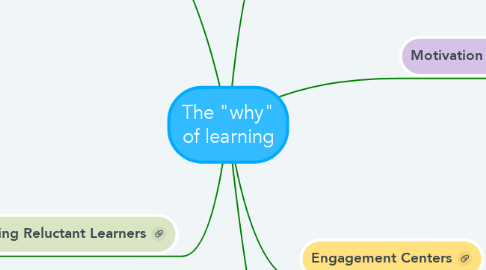The "why" of learning
by Jazmine Nava


1. Starting with Why
1.1. Companies who market their "why" for being in existence fair better than their competitors. Take Apple for example who has created such a following by standing by what they believe in and advertising why they do what they do not what or how they do it.
1.2. We naturally like to follow people who maintain consistent and authentic beliefs.
1.3. The greatest of leaders always start with why. People are inspired by them because of their passion and beliefs for what they stand for.
2. Motivating Reluctant Learners
2.1. Make information more easily digestible for students.
2.2. Post-It note discussions are a good way to get all students involved without making anyone uncomfortable by putting them on the spot.
2.3. Mind-streaming is a fun brain break activity that gives students a chance to recall what they’ve learned and teach one another. (Like a peer teaching pair-and-share.)
2.4. Use the Snowball Brain Break routine at the end of a lesson or day to summarize student learning. Anonymous and low risk since students are not sharing aloud.
2.5. Keep props around while you teach. Students can hold onto a stuffed animal for example while they share aloud in class.
2.6. Activate students with a quick round of voting. Put three learning goals for the day up on the board and ask students to vote for the one they think is most important. This helps build camaraderie.
3. Expert learners
3.1. characteristics of expert learners
3.1.1. motivated
3.1.2. knowledgable
3.1.3. strategic
3.2. Focused on mastery of learning not mastery of knowledge
4. Motivation
4.1. Studies have found that for simple straightforward tasks, incentives work well. However for higher cognitive tasks, higher incentives led to worse performance.
4.2. 3 factors that lead to better performance and satisfaction are: autonomy, mastery and purpose.
5. Creating Social Justice Classrooms
5.1. Connect to students' lives
5.2. Link to real-world problems and multiple perspectives
5.3. Create classroom community
5.4. Include authentic assessments
6. Engagement Centers
6.1. Choice Spinners
6.1.1. In my current class I would use choice spinners to increase engagement during a lesson. For example, a choice spinner could dictate a math problem to work on, a writing prompt, or a morning activity.
6.1.2. I wonder if choice spinners could be used for rewards.
6.2. Calming Strategies
6.3. Goal Setting
6.4. Flipped Classroom
6.4.1. students study new content independently prior to class session
